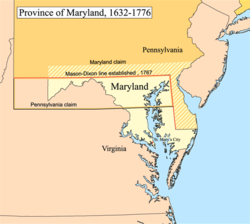
Back Province of Maryland German Province of Maryland English Provincia de Maryland Spanish Marylandin provinssi Finnish Province du Maryland French פרובינציית מרילנד HE Մերիլենդ (պրովինցիա) Armenian Provinsi Maryland ID Provincia del Maryland Italian メリーランド植民地 Japanese
Province of Maryland | |||||||||
|---|---|---|---|---|---|---|---|---|---|
| 1632–1776 | |||||||||
 Map of the Province of Maryland | |||||||||
| Status | Colony of England (1632–1707) Colony of Great Britain (1707–1776) | ||||||||
| Capital | St. Mary's City (1632–1695) Annapolis (from 1695) | ||||||||
| Common languages | English, Susquehannock, Nanticoke, Piscataway | ||||||||
| Religion | Anglicanism (de jure), Roman Catholicism (de facto) | ||||||||
| Government | Constitutional monarchy | ||||||||
| Royally Chartered Proprietor | |||||||||
• 1632–1675 | Lord Baltimore, 2nd | ||||||||
• 1751–1776 | Lord Baltimore, 6th | ||||||||
| Proprietary Governor | |||||||||
• 1634–1647 | Leonard Calvert | ||||||||
• 1769–1776 | Robert Eden | ||||||||
| Legislature | Maryland General Assembly | ||||||||
| History | |||||||||
• Charter granted | 1632 | ||||||||
| July 4 1776 | |||||||||
| Currency | Maryland pound | ||||||||
| |||||||||
| Today part of | United States | ||||||||
The Province of Maryland was an English colony that later became a British one. It existed from 1632 to 1776, when it joined the other Thirteen Colonies to fight against Great Britain. It is now a state of the United States called Maryland. Unlike the other colonies in the future united states, most settlers of the Province of Maryland were Roman Catholics, who had fled the European wars of religion. The Roman Catholic Archdiocese of Baltimore was the first Catholic diocese on American soil, the Baltimore Basilica was the first cathedral. The Maryland Toleration Act, signed 1649, was the first act that tolerated other Christian religious groups.

